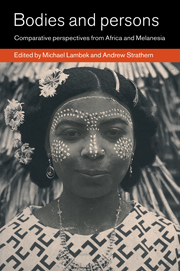Book contents
- Frontmatter
- Contents
- List of illustrations
- List of contributors
- Acknowledgments
- 1 Introduction: Embodying sociality: Africanist–Melanesianist comparisons
- Part I Transcending dichotomies
- Part II Transitions, containments, decontainments
- 6 Treating the affect by remodelling the body in a Yaka healing cult
- 7 To eat for another: taboo and the elicitation of bodily form among the Kamea of Papua New Guinea
- 8 Electric vampires: Haya rumors of the commodified body
- Part III From exchange to history
- Bibliography
- Index
6 - Treating the affect by remodelling the body in a Yaka healing cult
Published online by Cambridge University Press: 05 June 2012
- Frontmatter
- Contents
- List of illustrations
- List of contributors
- Acknowledgments
- 1 Introduction: Embodying sociality: Africanist–Melanesianist comparisons
- Part I Transcending dichotomies
- Part II Transitions, containments, decontainments
- 6 Treating the affect by remodelling the body in a Yaka healing cult
- 7 To eat for another: taboo and the elicitation of bodily form among the Kamea of Papua New Guinea
- 8 Electric vampires: Haya rumors of the commodified body
- Part III From exchange to history
- Bibliography
- Index
Summary
It is in the interplay of physical links and individualizing relationships a person weaves through the mother's lineage with the uterine source of life and the primary and fusional object that the Yaka culture in Kinshasa and south-west Congo (formerly called Zaire) localizes the origins of serious illness, infirmity, and also madness. By contrast, links of agnatic filiation issuing from the founder ancestor of the patriline define the social identity and norms: it is before the fathers and the paternal ancestry that the ideal versus deviant traits of the social subject are being defined. The social role and the identity processes are elaborated in the centre of public life and are conducted by the male patriarchs. They ensure that the social subject is assimilated into a system of filiation and seniority, most particularly through the ritualized imposition of a name, circumcision, and initiation into adolescence, as well as through political power (palaver, jurisdiction, and enthronement), marriage and bereavement, and the practices of competition, solidarity, and exchange (Devisch 1988).
The interweave between body and culture, the body's contact or experiencing zones and the cultural modelling, is studied here in the context of a therapeutic cult that operates and is transmitted through links of matrilineal or uterine descent. This initiatory therapy is organized on the margins of the established society (Devisch 1993a). Such therapeutic cults reenact, so to speak, the birth of the initiated into physical and social life: they reelaborate his various forms of contact, envelopment, and exchange on the sensory level.
- Type
- Chapter
- Information
- Bodies and PersonsComparative Perspectives from Africa and Melanesia, pp. 127 - 157Publisher: Cambridge University PressPrint publication year: 1998
- 1
- Cited by



